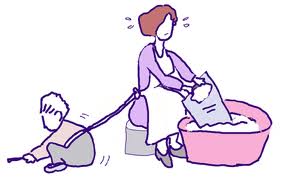もう一つ別の望ましくない形のごまかし(誤魔化し)は,無生物(生命のないもの)をあたかも生きているかのように扱うことである。子供が椅子やテーブルにぶつかって怪我をしたような場合,保母はときどき,子供に,その腹ただしいものをぴしゃり とたたき,「椅子のおバカさん」とか「テーブルのおバカさん」とか言うように教えることがある。これでは,せっかくの最も有益な自然なしつけの源(機会)をとりのぞいてしまう(ことになる)。(子供にかまわずに)子供をそのままにしておけば,生命のないものは技術によって操作するほかないもので,怒ったりおだてたりしてもどうしようもないと,すぐに理解する。これは,技術を身につけるための刺激となり,個人の力の限界を自覚する上で助けとなる。
とたたき,「椅子のおバカさん」とか「テーブルのおバカさん」とか言うように教えることがある。これでは,せっかくの最も有益な自然なしつけの源(機会)をとりのぞいてしまう(ことになる)。(子供にかまわずに)子供をそのままにしておけば,生命のないものは技術によって操作するほかないもので,怒ったりおだてたりしてもどうしようもないと,すぐに理解する。これは,技術を身につけるための刺激となり,個人の力の限界を自覚する上で助けとなる。
Another undesirable form of humbug is to treat inanimate objects as if they were alive. Nurses sometimes teach children, when they have hurt themselves by bumping into a chair or table, to smack the offending object and say, “naughty chair “, or’ ” naughty table “. This removes a most useful source of natural discipline. Left to himself, the child soon realizes that inanimate objects can only be manipulated by skill, not by anger or cajolery. This is a stimulus to the acquisition of skill, and a help in realizing the limits of personal power.
出典: On Education, especially in early childhood, 1926, Pt. 2:
Education of character, chap. 8: Truthfulness
詳細情報:http://russell-j.com/beginner/OE08-060.HTM
<寸言>
他人のせいではなく、物のせいにすることはあまり害を及ぼさないとかんがえやすいが、子どもが現実を理解する、あるいは、立ち向かう心性や態度を育てる障害となることから、好ましくない。
